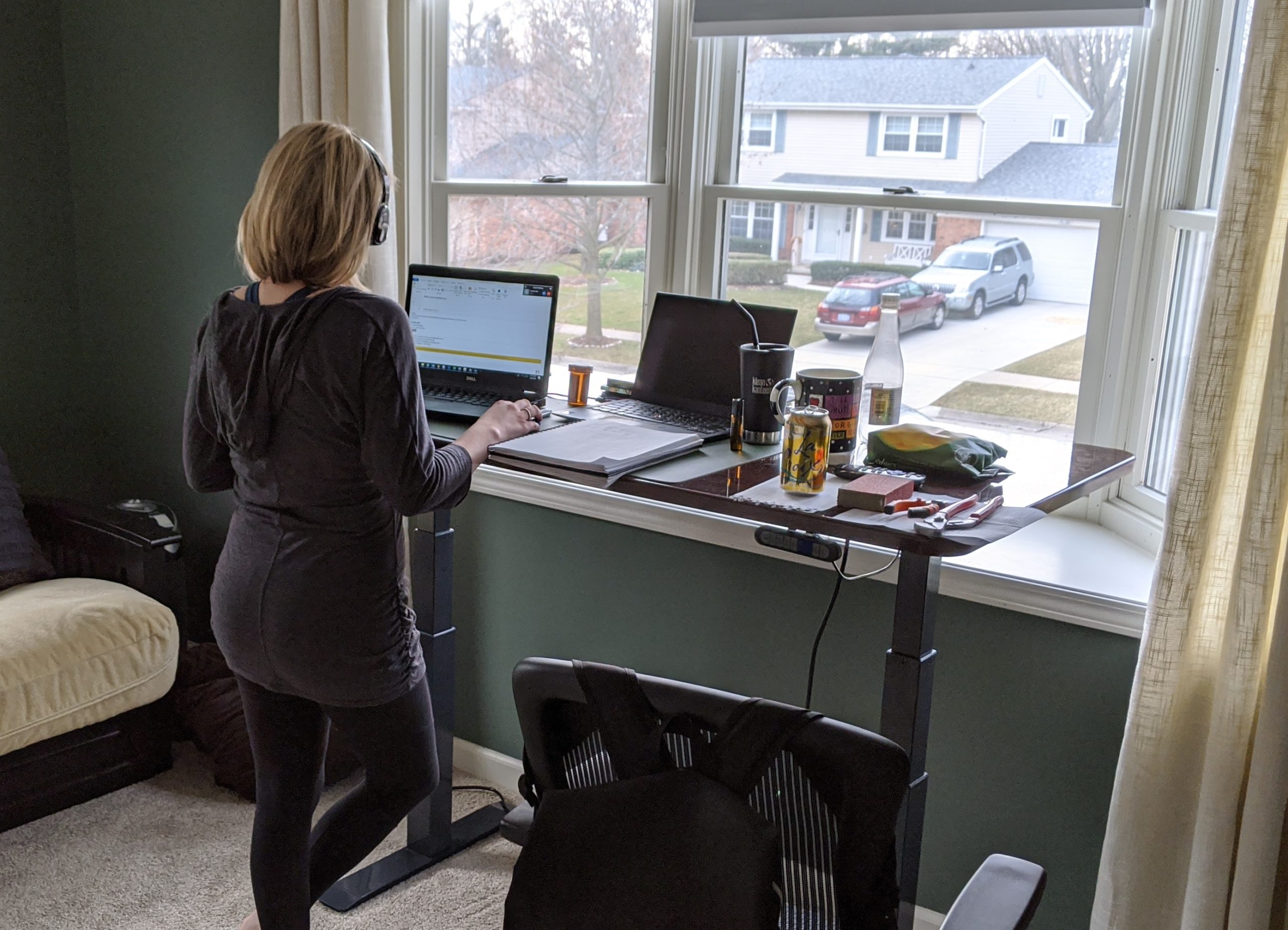In this new world in which we are currently living, many people are working from home.
Going on a “Zoom” has become pop culture lingo, whereas if you said it a few months ago, you would’ve gotten that tilted dog head look.
Working at home presents some newfound difficulties.
No home office? The dining room or kitchen table will do.
Workplace ergonomics? That Amazon box sure looks like an excellent mount for my laptop.
Monsters, excuse me; kids, at home? So this is what it feels like being pulled in two different directions at the same time.
Zoom meetings? This dress shirt tucks well into pajama pants.
Neck & back pain? You can still search for YouTube videos, but getting to your chiropractor or massage therapist is a no-go unless you’re open to telehealth.
The truth is all the postural and ergonomic strategies that work for you in the office will work at home as well. In fact, there’s more you can do at home that you couldn’t get away within the workplace.
Needless to say, “stuff” has hit the proverbial fan. That whole once-in-a-lifetime COVID-19 pandemic thing (we hope) has caused many to react with fear and anxiety.
Rightly so.
The forced change causes uncertainty.
Uncertainty causes anxiety.
Anxiety causes stress.
Stress is fuel on the fire. If you have muscle, joint, or nerve pain, stress makes it worse.
See the snowball effect going on here? Yeah, it accumulates fast. So, that’s why this post is a bit more holistic than just exercises to “fix” your neck pain or back pain.
How do we take care of our physical and mental health during these trying times?
1) Be Mindful When Working From Home
Mindfulness — why start with this? Because mindfulness is required to take advantage of any of the tips below.
Often, mindfulness gets associated with hippy-dippy, third eye, buddha in the stratosphere stuff. However, mindfulness simply means being conscious or aware of something.
During this time of unprecedented change, practicing mindfulness is more important than ever for or physical and mental health.
Merely being “aware” is half the battle. If you’re not aware, you can’t make changes. You cannot make changes to something of which you are unaware.
Watch this brief video for more about mindfulness, which will help with the following tips:
2) Create Boundaries & Maintain a Routine
When working from home it’s hard not to meld professional and personal life. And when you don’t have the accountability regarding being physically present at work, it’s easy to slack on your schedule. Ultimately, this leads to being there for your family but working all the darn time.
Don’t fall into this trap — it’s easy.
Setting up-front boundaries between your work versus home life, like an on-off switch, is critical. Otherwise, you get stuck into the hamster wheel of continually dodging bullets.
There’s an urgent Zoom meeting at ten. The insurance company called to update information. Sally is not being nice to Bobby, and it’s not fair. Why can’t anyone do their flipping jobs!? The fastidious neighbor needs the kid’s toys off the lawn immediately. There’s no cover sheet on the TPS reports. If you could do that for now on, that would be great…yeah.
Yeah, keep that up, and you’ll go insane in no time. Establish your boundaries. Also, stick to a workday routine. Here are some tips:
- Establish working hours and let your family know you are not available (unless emergency, of course) during those times.
- Set a time to start and finish the day.
- Get dressed before work in the same attire you would wear into the office that day.
- Create a weekly schedule with time for breaks, meals, exercise, and family time.
- Turn your work emails and notifications off when you’re finished working.
- Modify your schedule as needed, but continue to stick to the schedule.
3) Take Breaks
It seems like an easy task to take breaks while working from home; however, said breaks tend to be the distractions mentioned above.
Interruptions and distractions are not breaks!
Postural breaks and ergonomic strategies are essential. Curious about what strategies we’re using right now?
It’s equally as important to take mental breaks as is physical breaks. For every 30 minutes of working, take a microbreak. Stand up, do a quick stretch, use the bathroom, whatever. Well, maybe not hopping on social media!
It’s also a good idea to take a more extended break every couple of hours or so. Some options during your break time:
- Go for a stroll
- Get in a quick workout
- Take a 20-minute power nap
- Meditate (Headspace app is a great place to start)
- Brief reading (preferably from paper) for enjoyment
It’s easy to minimize the idea of taking breaks. Nevertheless, taking breaks while working at home is like opening the release valve, helping you be focused and productive throughout the working hours you’ve established from tip two above!
4) Eat Well While Working From Home
In stressful times, it can be a real struggle to eat well. If you don’t typically prepare your meals at home, the thought of learning how creates another layer of stress!
Speaking of stress, what do we eat when we’re stressed? Crap. Exactly.
Crappy food high in refined sugar, grains, and vegetable oils is highly inflammatory. Junk food gives you immediate satisfaction, but you pay for it later.
Systemic inflammation as our body’s reaction to the food we’re eating causes a myriad of longterm adverse effects like heart disease, diabetes, chronic pain, and premature aging. In the short term, you’ll just feel “off” unable to perform your best.
Whether you’re going to cook at home or support your local restaurants by ordering out, here are some nutrition tips to fuel your body efficiently, running on all cylinders:
- Avoid food high in refined sugar, grains, and vegetable oils. Easier said than done, especially if you’re ordering out. Here is a wonderful resource you can download and print right now.
- Opt for high-quality food. Yes, organic, grass-fed, pasture-raised is more expensive. What’s more costly is fighting disease later in life. Make the investment now. Here’s a guide to food quality you can download and print right now.
- Eat real meals. No boxed stuff.
- Eat with family and without outside distractions, e.g., television, devices.
- Take your time to consume your meal, stopping when you’re satisfied rather than full or “stuffed.”
For more tips on nutrition as well as boosting your immunity with supplementation, check out this post.
5) Don’t Be So Hard on Yourself
Working from home is a big adjustment especially if you’re not used to it, and it’s even more true during a time of crisis.
You were probably not prepared for this.
You may not have a home office or a dedicated workspace.
Your kids are at home, rather than at school.
The house might feel crowded and not conducive to work.
Maybe you’re under a lot of stress with work, or financial difficulties, or illness in the family.
We’re with you on all that. We weren’t prepared either — none of us were! The COVID-19 pandemic is pulling us in both directions and we’re spreading ourselves thin.
We can only control what we can control, and we can’t control what we can’t control.
Just because the pandemic is pushing us doesn’t mean we have to push back harder. It’s okay to cut ourselves some slack. Spend time with family. Work on that project you’ve been putting off. Finally, start learning how to play an instrument.
Focus on what you can control, forget about the rest, and tell those close to you you love them. Don’t be so hard on yourself — you’re going to be alright!
We’ve Got Your Back,
The REACH Team
P.S. We’re excited to announce we just released three new movement courses! The best part is they’re absolutely free! Yes, all you need to do is click here to see the course catalog and pick what you want to learn. Working with so many people we’ve noticed most struggle with a lot of the same issues. What we also noticed is the same people don’t move (or know how to move) their bodies enough and in a variety of ways. Check out our free courses now!


